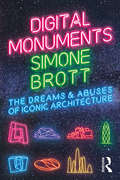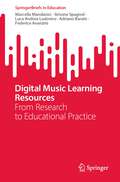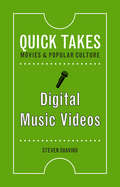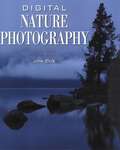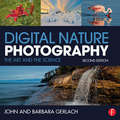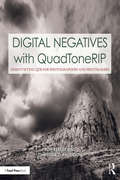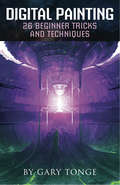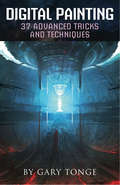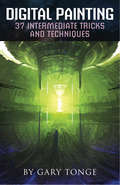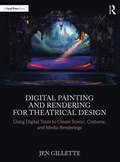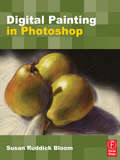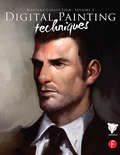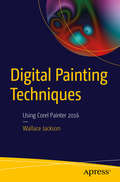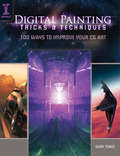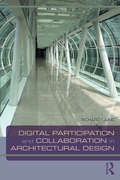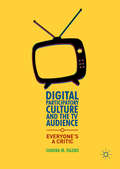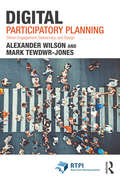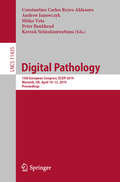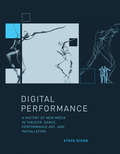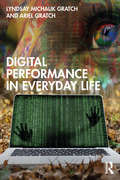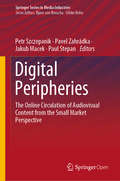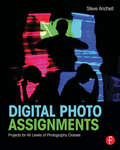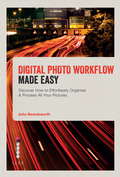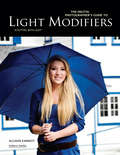- Table View
- List View
Digital Monuments: The Dreams and Abuses of Iconic Architecture
by Simone BrottDigital Monuments radically explodes "iconic architecture" of the new millennium and its hijacking of the public imagination via the digital image. Hallucinatory constructions such as Rem Koolhaas’s CCTV headquarters in Beijing, Frank Gehry’s Guggenheim Museum in Bilbao and Zaha Hadid’s Performing Arts Centre in Abu Dhabi are all introduced to the world by immortal digital imagery that floods the internet—yet comes to haunt the actualised buildings. Like holograms, these "digital monuments," which violently push physics and engineering to their limits, flicker eerily between the real and the unreal—invoking fantasies of omnipotence, immortality and utopian cities. But this experience of iconic architecture as a digital dream on the ground conceals from the urban spectator the social reality of the buildings and the rigidity of their ideology. In 18 micro-essays, Digital Monuments exposes the stereotypes of iconic architecture while depicting the savagery of the industry, from the Greek and Spanish crises triggered by financialised iconic development to mass labour-deaths on construction sites in the UAE.
Digital Music Learning Resources: From Research to Educational Practice (SpringerBriefs in Education)
by Marcella Mandanici Simone Spagnol Luca Andrea Ludovico Adriano Baratè Federico AvanziniThis book offers an overview of the complex world of digital materials for music education and of their possible use in the everyday practice of music teachers. It presents a multidimensional taxonomy of digital materials for music education. Through the taxonomy it is possible to derive a clear framework of the whole field and to perform analysis of the state of art. The book shows the use of this flexible and powerful knowledge tool for reviewing the digital materials in the various domains and dimentions. The book provides researchers and designers with an overview of what has already been designed, proposed and tested in the field. It also offers music teachers a wider perspective of the possibilities connected to current technologies in the field of music education, and it suggests possible interrelationships between research and music education practices.
Digital Music Videos
by Steven ShaviroMusic videos today sample and rework a century’s worth of movies and other pop culture artifacts to offer a plethora of visions and sounds that we have never encountered before. As these videos have proliferated online, they have become more widely accessible than ever before. In Digital Music Videos, Steven Shaviro examines the ways that music videos interact with and change older media like movies and gallery art; the use of technologies like compositing, motion control, morphing software, and other digital special effects in order to create a new organization of time and space; how artists use music videos to project their personas; and how less well known musicians use music videos to extend their range and attract attention. Surveying a wide range of music videos, Shaviro highlights some of their most striking innovations while illustrating how these videos are creating a whole new digital world for the music industry.
Digital Nature Photography
by Jon CoxDigital Nature Photography is the definitive how-to book on photographing nature with a digital camera. Focusing primarily on the art of taking the picture in the field--rather than just manipulating the image after it has been shot--this comprehensive guide is geared to the nature photographer who is fairly new to the world of digital cameras. Packed with step-by-step directions and resplendent full-color examples from the author's own body of work, readers will receive hands-on practice with lighting, composition, landscapes, sunrises, sunsets, animal portraits, close-ups, manipulating and storing images, and much more. The essential reference for every level of photographer, Digital Nature Photography guides the reader through a magnificent and unique visual experience into the natural world.
Digital Nature Photography: The Art and the Science
by John and GerlachIdentifying a beautiful image in nature is easy, but capturing it is often challenging. To truly seize the essence of a photograph shot out of the studio and in the world requires an artistic eye and impeccable set of photographic techniques. John and Barbara Gerlach have been teaching photographers how to master the craft of photographing nature and the outdoors through their workshops and best-selling books for more than twenty years. Now, equipped with brand new images to share and skills to teach, this celebrated photo team is sharing their latest lessons in the second edition of Digital Nature Photography. Notable revisions in this new edition include introducing the concepts of focus stacking and HDR, as well as expanded discussions of multiple exposure, wireless flash, RGB histograms, live view, shutter priority with auto ISO, hand-held shooting techniques, and the author’s equipment selections. The inspiring imagery in this book covers a broader range of subjects than before including ghost towns, the night sky, animals, and sports, in addition to the classic nature photographs we expect from this very talented author team. This book is a comprehensive guide to one of the broadest subjects in photography, explained and dymystified by two respected masters.
Digital Negatives with QuadToneRIP: Demystifying QTR for Photographers and Printmakers (Contemporary Practices in Alternative Process Photography)
by Ron Reeder Christina Z AndersonDigital Negatives with QuadToneRIP is a text that fully explores how the QuadToneRIP printer driver can be used to make expert digital negatives. The book takes a comprehensive, Òunder-the-hoodÓ look at how Roy Harrington’s QTR printer driver can be adapted for use by artists in several different creative practice areas. The text is written from the Mac/Photoshop point of view. The book is divided into three parts. Part One is a step-by-step how-to section that will appeal to both beginning and more advanced practitioners. Part One includes quickstart guides or summary sheets for beginning students who want to jump into using QTR before understanding all of its functional components. Part Two addresses dimroom, darkroom, and printmaking practices, walking the reader through brief workflows from negative to print for lithium palladium, gum bichromate, cyanotype, salted paper, kallitype, silver gelatin and polymer photogravure, with a sample profile for each. It also includes an introduction to a new software iteration of QTR: QuickCurve-DN (QCDN). Part Three is devoted to contemporary practitioners who explain how they use QTR in their creative practice. The book includes: A list of supplies and software needed A summary QTR glossary with a simple explanation of how each function works A sample walk-through to create a QTR profile from start to finish How to linearize profiles with simple to more exacting tools A visual guide to modifying functions Quickstart guides for many of the workflows Instructions for crafting monochrome, duotone, tricolor, and quadcolor negatives Instructions for using QTR to print silver gelatin in the darkroom Instructions for using QTR to print alternative processes in the dimroom Instructions for using QTR to print polymer photogravure in the printmaking room Introductory chapter to QuickCurve-DN software Troubleshooting common QTR problems Generic starter profiles for processes discussed Contemporary artists: their work and QTR process. Learning how to craft expert digital negatives can be a bit overwhelming at the outset. Digital Negatives with QuadToneRIP makes the process as user-friendly as possible. Like other books in the series, Digital Negatives with QuadToneRIP is thoroughly comprehensive, accessible to different levels of learner, and illustrative of the contemporary arts.
Digital Painting, 26 Beginner Tricks and Techniques
by Gary TongeDigital Painting, 26 Beginner Tricks and Techniques will show you how to get more out of your software and improve your digital artwork. Gary Tonge, one of the world's leading digital art pros, offers state-of-the-art advice for beginners covering every aspect of computer-generated art--from lighting and color basics to working with layers. Clear instruction, screen shots and striking art make these tips immediately applicable so you can begin right away.
Digital Painting, 37 Advanced Tricks and Techniques
by Gary Tonge"Make the most of your digital artwork. State-of-the-art advice from Gary Tonge, one of the world's leading digital art pros, covers every aspect of computer-generated art--from combining a range of source material into one cohesive image to adding super realistic effects. Eight step-by-step demonstrations offer advanced level instruction, making these tips immediately applicable so you can begin right away. With real-world perspective and a practical focus, this is a powerful resource. By applying the techniques inside, you'll push yourself out of your comfort zone and into bold new territory. "
Digital Painting, 37 Intermediate Tricks and Techniques
by Gary Tonge"Make the most of your digital artwork. State-of-the-art advice from Gary Tonge, one of the world's leading digital art pros, covers every aspect of computer-generated art--from combining a range of source material into one cohesive image to adding super realistic effects. Eight step-by-step demonstrations offer advanced level instruction, making these tips immediately applicable so you can begin right away. With real-world perspective and a practical focus, this is a powerful resource. By applying the techniques inside, you'll push yourself out of your comfort zone and into bold new territory. "
Digital Painting and Rendering for Theatrical Design: Using Digital Tools to Create Scenic, Costume, and Media Renderings
by Jen GilletteDigital Painting and Rendering for Theatrical Design explores the tools and techniques for creating dazzling, atmospheric, and evocative digitally painted renderings for scenic, costume, and projection/integrated media design. By focusing on technique rather than the structure of a particular software, this book trains theatrical designers to think and paint digitally, regardless of the software or hardware they choose. The text begins with the construction of the artist’s physical and digital workspace, then delves into an explanation of tool functionality, technique-building exercises, and examples from professional theatrical designers to help contextualize the concepts presented. Each chapter gradually progresses in complexity through skill-building exercises and advanced tool functionality, covering concepts like brush construction, various forms of masking, and layer interaction. The book explores various methods of constructing a digital rendering, including producing digital paintings that look like traditional media and photo bashing – the practice of using extant photographs to create a collaged image. Concepts are contextualized throughout the text using illustrations, quotes, and interviews with working professional designers. This beautifully illustrated guide is written for professional theatrical artists, students of theatrical design, and other visual artists looking to broaden their digital painting skillset.
Digital Painting in Photoshop
by Susan Ruddick BloomHave you ever considered using Photoshop to create fine art?Photoshop is usually used for enhancing photos, but this extremely powerful software package is capable of so much more. Every feature, from brushes to background, can be customised and optimised for artistic effect. With a little guidance from a pro, your photoshop results can go from competent retouching of images to visually stunning re-interpretations of them, turning everyday pictures into breathtaking works of art.In this beautiful and inspiring book, acclaimed artist, author and lecturer Susan Bloom shows you how to do just that. Starting with the fundamentals: creating your own artistic brushes and textured papers virtually, she goes on to demonstrate how to create a variety of classic artistic styles in Photoshop, with chapters on watercolours, pastels, charcoal and oil. Further chapters cover illustration techniques in photoshop, and using third-party software to create painterly effects.While the results are highly polished and realistic, this is not a book written specifically for artists. The techniques are aimed squarely at the Photoshop user looking to broaden their pallette, with emphasis on altering photographs to create artwork, rather than creating artwork from scratch. Beautifully written, clearly laid out, and guaranteeing inspiring results, this book is a must-have for every Photoshop user.
Digital Painting Techniques: Masters Collection
by 3dtotal.ComDiscover the tips, tricks and techniques that really work for concept artists, matte painters and animators. Compiled by the team at 3dtotal.com, Digital Painting Techniques, Volume 1 offers digital inspiration with hands-on insight and techniques from professional digital artists. More than just a gallery book - within Digital Painting Techniques each artist has written a breakdown overview, with supporting imagery of how they made their piece of work. Beginner and intermediate digital artists will be inspired by the gallery style collection of the finest examples of digital painting from world renowned digital artists. Start your mentorship into the world of digital painting today with some of the greatest digital artists in the world and delve into professional digital painting techiques, such as speed painting, custom brush creation and matte painting. Develop your digital painting skills beyond the variety of free online digital painting tutorials and apply the most up to date techniques to your digital canvas with Digital Painting Techniques for Animators.
Digital Painting Techniques
by Wallace JacksonLearn the foundational concepts of vector graphics and raster imaging, including what new media formats are best for use with Android Studio, Java and JavaFX, iOS, Kindle and HTML5, as well as key factors regarding the data footprint optimization work process, and why data footprint optimization is important. Digital Painting Techniques covers concepts central to digital painting using the Inkscape 0. 91 open source software package as well as the Corel Painter 2016 professional digital painting software package. What you'll learn The terminology of digital painting What comprises a digital painting 2D modeling and rendering pipeline Concepts and principles behind digital painting content production How to install and utilize 64-bit Inkscape 0. 91 and Corel Painter 2016 Concepts behind curves, strokes, fills, patterns, rendering and physics Digital painting data formats and data footprint optimization Who this book is for Digital artists, illustrators, painters, user interface designers, digital signage content developers, e-learning content creators, ebook cover artists, album cover artists Secondary: Android developers, iOS developers, website developers, Flash developers, multimedia producers, rich internet application (RIA) programmers, game designers, teachers, educators. Table of Contents Chapter 1 Digital Painting Software: Corel Painter and Inkscape Chapter 2 The Terminology of Digital Painting: Vector and Raster Chapter 3 The Foundation of Digital Painting: Canvas and Brush Chapter 4 The Hardware of Digital Painting: Tablet and Stylus Chapter 5 The Brushes of Digital Painting: Patterns and Paths Chapter 6 The Depth of Digital Painting: Using Gradients Chapter 7 The Imagery of Digital Painting: Using Patterns Chapter 8 The Rendering of Digital Painting: Data Formats Chapter 9 The Vectorization of Digital Imagery: Creating Shapes Chapter 10 The Algorithms of Digital Painting: Plug-In Filters Chapter 11 The Customization of Digital Painting: Brush Design Chapter 12 The Airbrush of Digital Painting: Physics Engines Chapter 13 The Compositing of Digital Painting: Using Layers Chapter 14 The Flexibility of Digital Painting: Image Editing Chapter 15 The Automation of Digital Painting: Programming Chapter 16 Publish Digital Paintings: Content Delivery Platforms
Digital Painting Tricks & Techniques: 100 Ways to Improve Your CG Art
by Gary TongeThis book provides all the advice artists need to transform their digital painting--from brush, lighting and color basics to special effects, working with layers, and speed and matte painting. The 100+ expert tricks provide quick and easy solutions to all aspects of digital painting through clear instructions, step-by-step demonstrations and breathtaking annotated art. The book is divided into core elements of digital painting providing beginner, improver and advanced techniques to ensure progression and relevance to all skill levels, making it ideal for beginners and essential for more experienced digital painters. This is the ultimate tool to help emerging CG artists get started with digital painting, and help advanced CG artists improve their digital painting techniques.
Digital Participation and Collaboration in Architectural Design
by Richard LaingThe emergence of new digital and visualisation technologies in recent years has led to rapid changes in the field of architecture. Current drives to incorporate building information modelling as a part of architectural design are giving way to the increased use of IT and visualisation in architectural design, user participation and group collaboration. As digital methods become more mainstream, Digital Participation and Collaboration in Architectural Design provides an accessible and engaging introduction to this emerging subject. Supported by selected examples from research and practice, the book offers an overview of theories, techniques and approaches which readers can apply in their own work. In doing so, it shows how these techniques can influence communication, debate and understanding and encourages readers to see familiar buildings from original and unusual perspectives. An ideal starting point for anyone interested in the application of digital techniques, the book will help students and professionals in architectural design and digital architecture to understand and embrace new technologies.
Digital Participatory Culture and the TV Audience
by Sandra M. FaleroIn this study, Falero explores how online communities of participatory audiences have helped to re-define authorship and audience in the digital age. Using over a decade of ethnographic research, Digital Participatory Culture and the TV Audience explores the rise and fall of a site that some heralded as ground zero for the democratization of television criticism. Television Without Pity was a web community devoted to criticizing television programs. Their mission was to hold television networks and writers accountable by critiquing their work and "not just passively sitting around watching. " When executive producer Aaron Sorkin entered Television Without Pity's message boards on The West Wing in late 2001, he was surprised to find the discussion populated by critics rather than fans. His anger over the criticism he found there wound up becoming a storyline in a subsequent episode of The West Wing wherein web critics were described as "obese shut-ins who lounge around in muumuus and chain-smoke Parliaments. " This book examines the culture at Television Without Pity and will appeal to students and researchers interested in audiences, digital culture and television studies.
Digital Participatory Planning: Citizen Engagement, Democracy, and Design (RTPI Library Series)
by Alexander Wilson Mark Tewdwr-JonesDigital Participatory Planning outlines developments in the field of digital planning and designs and trials a range of technologies, from the use of apps and digital gaming through to social media, to examine how accessible and effective these new methods are. It critically discusses urban planning, democracy, and computing technology literature, and sets out case studies on design and deployment. It assesses whether digital technology offers an opportunity for the public to engage with urban change, to enhance public understanding and the quality of citizen participation, and to improve the proactive possibilities of urban planning more generally. The authors present an exciting alternative story of citizen engagement in urban planning through the reimagination of participation that will be of interest to students, researchers, and professionals engaged with a digital future for people and planning.
Digital Pathology: 15th European Congress, ECDP 2019, Warwick, UK, April 10–13, 2019, Proceedings (Lecture Notes in Computer Science #11435)
by Constantino Carlos Reyes-Aldasoro Andrew Janowczyk Mitko Veta Peter Bankhead Korsuk SirinukunwattanaThis book constitutes the refereed proceedings of the 15th European Congress on Digital Pathology, ECDP 2019, held in Warwick, UK in April 2019. The 21 full papers presented in this volume were carefully reviewed and selected from 30 submissions. The congress theme will be Accelerating Clinical Deployment, with a focus on computational pathology and leveraging the power of big data and artificial intelligence to bridge the gaps between research, development, and clinical uptake.
Digital Performance: A History of New Media in Theater, Dance, Performance Art, and Installation (Leonardo)
by Steve DixonThe historical roots, key practitioners, and artistic, theoretical, and technological trends in the incorporation of new media into the performing arts.The past decade has seen an extraordinarily intense period of experimentation with computer technology within the performing arts. Digital media has been increasingly incorporated into live theater and dance, and new forms of interactive performance have emerged in participatory installations, on CD-ROM, and on the Web. In Digital Performance, Steve Dixon traces the evolution of these practices, presents detailed accounts of key practitioners and performances, and analyzes the theoretical, artistic, and technological contexts of this form of new media art. Dixon finds precursors to today's digital performances in past forms of theatrical technology that range from the deus ex machina of classical Greek drama to Wagner's Gesamtkunstwerk (concept of the total artwork), and draws parallels between contemporary work and the theories and practices of Constructivism, Dada, Surrealism, Expressionism, Futurism, and multimedia pioneers of the twentieth century. For a theoretical perspective on digital performance, Dixon draws on the work of Philip Auslander, Walter Benjamin, Roland Barthes, Jean Baudrillard, and others. To document and analyze contemporary digital performance practice, Dixon considers changes in the representation of the body, space, and time. He considers virtual bodies, avatars, and digital doubles, as well as performances by artists including Stelarc, Robert Lepage, Merce Cunningham, Laurie Anderson, Blast Theory, and Eduardo Kac. He investigates new media's novel approaches to creating theatrical spectacle, including virtual reality and robot performance work, telematic performances in which remote locations are linked in real time, Webcams, and online drama communities, and considers the "extratemporal" illusion created by some technological theater works. Finally, he defines categories of interactivity, from navigational to participatory and collaborative. Dixon challenges dominant theoretical approaches to digital performance—including what he calls postmodernism's denial of the new—and offers a series of boldly original arguments in their place.
Digital Performance in Everyday Life
by Lyndsay Michalik Gratch Ariel GratchDigital Performance in Everyday Life combines theories of performance, communication, and media to explore the many ways we perform in our everyday lives through digital media and in virtual spaces. Digital communication technologies and the social norms and discourses that developed alongside these technologies have altered the ways we perform as and for ourselves and each other in virtual spaces. Through a diverse range of topics and examples—including discussions of self-identity, surveillance, mourning, internet memes, storytelling, ritual, political action, and activism—this book addresses how the physical and virtual have become inseparable in everyday life, and how the digital is always rooted in embodied action. Focusing on performance and human agency, the authors offer fresh perspectives on communication and digital culture. The unique, interdisciplinary approach of this book will be useful to scholars, artists, and activists in communication, digital media, performance studies, theatre, sociology, political science, information technology, and cybersecurity—along with anyone interested in how communication shapes and is shaped by digital technologies.
Digital Peripheries: The Online Circulation of Audiovisual Content from the Small Market Perspective (Springer Series in Media Industries)
by Petr Szczepanik Pavel Zahrádka Jakub Macek Paul StepanThis is an open access book. Media industry research and EU policymaking are predominantly tailored to large (and, in the latter case, Western) European markets. This open access book addresses the specific qualities of smaller media markets, highlighting their vulnerability to global digital competition and outlining survival strategies for them. New online distribution models and new trends in the consumption of audiovisual content are limited by, and pose new challenges for, existing audiovisual business models and their legal framework in the EU. The European Commission’s Digital Single Market (DSM) strategy, which was intended e.g. to remove obstacles to the cross-border distribution of audiovisual content, has triggered a heated debate on the transformation of the existing ecosystem for European screen industries. While most current discussions focus on the United States, Western Europe, and the multinational giants, this book approaches these industry trends and policy questions from the perspective of relatively small and peripheral (in terms of their population, language, cross-border cultural flows, and financial and/or symbolic capital) media markets.
Digital Photo Assignments: Projects for All Levels of Photography Classes (Photography Educators Series)
by Steve AnchellThis collection of more than 40 photo assignments is designed to help all students—from beginning freshmen to experienced seniors—improve or reinvigorate their work and reach their full potential as photographers. Whether you are building a syllabus for your first photography class, revitalizing assignments for your students, or looking to add DSLR video, workflow, or color correction to your class, you will find a wealth of ideas in this wonderful working guide. The assignments begin with using the camera, and progress through learning composition and lighting, working in genres, building a portfolio and more.
Digital Photo Workflow Made Easy: Discover How to Effortlessly Organise & Process All Your Pictures
by John BeardsworthDo you know where all your photos are? Can you retrieve every landscape shot or portrait you've ever taken with a few keystrokes and a click of the mouse? Are you looking forward to processing those hundreds or thousands of holiday snapshots? There's no reason why you shouldn't, and this book holds all the answers, and quite a few expert secrets as well.Learn to take advantage of the processes and features of your software of choice to streamline your photo workflow. With advanced methods, tried and tested by an expert photographer, you'll be set on a straightforward path to great, reliable results in no time at all.
Digital Photo Workflow Made Easy: Discover How To Effortlessly Organise And Process All Your Pictures
by John BeardsworthQuickly make the most of the pictures you've taken. Photographers often talk of the dry, mechanical term "workflow" but what they mean is using modern software from iPhoto to Lightroom to bring lightning speed to their creative vision. <P><P>From family days out to professional studio shoots, it's never been more important to quickly handle hundreds and thousands of photographs without losing any or getting swamped. That's what this book is all about. This book covers everything from camera and computer equipment to the main software tools, as well as simple techniques you can use to manage your approach more successfully. You'll quickly become efficient without spending thousands on extra gear; perfect for shutterbugs who'd rather enjoy their photography than spend their lives hunting through hard drives and websites.
The Digital Photographer's Guide to Light Modifiers
by Allison EarnestFocusing exclusively on light modifiers and making the most of the least equipment, this in-depth handbook is ideal for use by the beginner and advanced amateurs who wish to take their photography to the next level. Including diagrams and lighting set scenes to facilitate learning and adapting technique, step-by-step critiques of several portrait sessions, and an extensive review of a variety of light modifying tools#151;from barn doors and snoots to gels, umbrellas, and strip boxes#151;this invaluable textbook style book reveals the precise steps for obtaining dimension and depth for indoor and outdoor portrait sessions. This resource is a must-have for beginner photographers looking to discover a treasure trove of fresh, creative lighting inspiration, that will surely help add diversity and creative style to your photography
